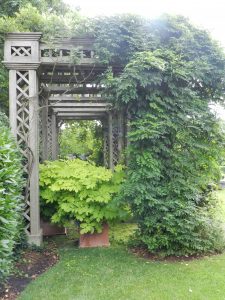
My Aralia ‘Sun King’ is sited between the cutleaf Japanese maple, Acer palmatum ‘Viridis’and a red-leafed banana, Ensete maurielii, for both color and textural contrast.
The Perennial Plant of the Year 2020 is Aralia ‘Sun King’, a high-impact, low maintenance, Asian perennial that is hardy in zones 3-9. Unlike the French king Louis XIV, also known as the Sun King, this sun king is the perfect anchor for the shade or part shade border, bringing a bold pop of glowing color and texture. “Discovered” by plantsman Barry Yinger in a Japanese garden center (atop a department store), this perennial has become a beloved shade garden staple across the country.

I am growing another ‘Sun King’ in the shade where is the color is much more of a pale chartreuse.
I’ve had this stunning perennial in my garden since 2016 in a northeast facing bed. The bright yellow shoots that emerge in spring on reddish brown stems (quickly hidden by the large leaves) grow at least three feet tall wide but can grow as tall and wide as six feet. However, it takes well to pruning if you want to keep it shorter.
This tropical-looking beauty, with its large compound leaves, is a special addition or focal point in a shaded bed where most foliage is green. If you can site this aralia so that it receives a few hours of sun, the leaves will be yellow. Otherwise, the foliage will be more chartreuse.

Although I grow ‘Sun King’ for its foliage, I also enjoy its flowers and berries in late summer and fall.
In late summer, the small, creamy-white umbels of flowers are attractive to humans and to bees and are followed by tiny dark purple, inedible berries. Unlike other spikenards, this one is very well behaved with little to no reseeding or suckering.

While meant for shade and part shade gardens, this aralia will be fine in full sun if irrigated. It is shown here in a sunny perennial garden with Phlox behind and peony foliage in front.
Aralia ‘Sun King’ would prefer loamy, well-drained soil but will grow well in less than ideal conditions as long as it receives sufficient moisture. Like most herbaceous perennials, it will die back to the ground during the winter.

This ‘Sun King’ specimen has outgrown its container. It must have been well-watered.
‘Sun King’ makes a wonderful foil for the usual woodland perennials such as hosta, ferns, Polygonatum odoratum ‘Variegatum’ and Brunnnera macrophylla ‘Jack Frost’. It also provides great color and textural contrast with red and purple foliage woodies such as one of the Acer palmatum cultivars. It can also be used to stunning effect in large containers, much more interesting than the standard planting of shade annuals like begonias and Impatiens.
I know you will find many uses for this special perennial.


0 Comments